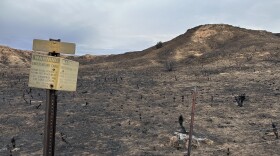From the panhandle to its eastern border, the opioid crisis has reached every corner of Oklahoma. Visit any of the state's 77 counties, any school district, tribe or community, and you will meet people who have lost a loved one or seen them struggle.
At the peak of the crisis in 2023, 810 people died of opioid overdoses in Oklahoma, adding to thousands more deaths over the course of a decade.
In the last six years, nearly 40% of the people who have died, including Diane Searle's daughter, have been younger than 35.
"And for the parents that think, 'oh, my kid would never do that,'" Searle said. "Those are very dangerous words, because I have 452 families that you can talk to."
Searle started an advocacy and support group in Tulsa, called Families Supporting Families, after she lost her 19-year-old daughter, Jillian, to a heroin overdose in 2018.
"She had a great sense of humor. She was like the clown of the whole house. She loved animals. She loved her siblings," said Searle, who wears a picture of Jillian on a purple lanyard around her neck. "She never thought she was popular. It was something she always struggled with. She's absolutely beautiful and she never really thought she was either."
Families Supporting Families was made up of five mothers but quickly grew, Searle said. At first, she'd find people through obituaries or newspaper articles. Now, they find her. A registered nonprofit, the group hands out harm reduction supplies, holds assemblies at local schools, helps parents navigate legal battles and pools together money for overdose-awareness billboards.
As a direct result of deaths of Oklahomans like Searle's daughter, the state has won more than $900 million from the distributors, pharmacies and companies that profited most from opioid sales. It's a portion of the nearly $50 billion in settlement funds awarded via lawsuits to states so far.
The money comes from lawsuits filed by attorneys general throughout the country claiming corporations misleadingly promoted prescription opioids, leading to widespread addiction and devastation.
In 2019, out of more than 2,000 others filed around the nation, an Oklahoma lawsuit against Johnson & Johnson was the first case against an opioid manufacturer to go to trial. A ruling ordering the manufacturer to pay the state millions was later overturned by the U.S. Supreme Court, but litigation inspired legal action against other companies in the industry.
Now, Searle and other community members have questions about where the money is going — and whether it's helping those most in need.
"It should be public knowledge," Searle said. "My kid died from opiates, she's one of the statistics from that, so we should have public knowledge of what you're spending it on."

Follow the money
So far, at least $68.5 million of Oklahoma's opioid settlement money has gone to private attorneys in charge of the state's litigation.
In 2019, another nearly $200 million was earmarked specifically for Oklahoma State University's National Center for Wellness and Recovery in Tulsa, which reports to have used about 14% of that total so far to advance opioid research and support an addiction clinic and specialized medical fellowship position.
The legislature also appropriated $27.4 million from the fund per year to several state agencies in 2020 and 2021. The money plugged budget holes in several agencies' existing costs. At the Oklahoma Health Care Authority, for example, the almost $24,000 it received had no spending restrictions and was used on Medicaid program expenditures.
For advocates like Searle, the fact that money could be going anywhere else but awareness, prevention and treatment is unacceptable.
"People need to have more knowledge of what's going on," she said. "They need to have better rehabs that people can stay in for a longer time to get the help they need."
When her daughter was in active addiction, Searle said she tried everything she could think of to get help, but practitioners who didn't understand Medicaid policies, long wait times and fractured care, made her efforts feel like a constant uphill battle.
She said supporting someone you love through addiction is one of the hardest things a person can do — and success relies heavily on the resources you have available.
The toll of the crisis
Oklahoma has seen a sharp rise in opioid overdose deaths over the past five years, with fentanyl driving much of the increase. The largest number of deaths have been concentrated in Oklahoma and Tulsa counties, but some of the highest overdose death rates per capita are in rural parts of the state.
In Pawnee County, where the population is just over 16,000, the rate of fentanyl-related deaths in 2022 and 2023 was roughly double the statewide average.

Tribal nations have also faced especially heavy losses, with overdose rates outpacing other groups at a rate that rivaled some of the hardest-hit regions in Appalachia.
Rebekah Brown is an active member of Searle's group. For her, every day is another without her son, who died at 18.
"I even have a text from him that I just read the other day and it said, 'mom, can you at least live until I'm 30?' And I said, 'Cole, I'm going to at least live to 85, I can guarantee you that,'" Brown said. "And he said, 'oh okay good because I don't know how I'd live without you here."
Brown said she made him promise he'd outlive her, but that didn't happen.
After Cole died in 2021, Brown said she had a hard time leaving the house. She said she felt alone and had dark thoughts she'd never experienced before. Joining an advocacy group and finding community has been an important part of her healing process, she said.
Late starts
There is currently $30.7 million from opioid settlements in a legislative holding fund, according to Alex Gerszewski, a spokesperson for the Oklahoma Senate president pro tempore's office. Lawmakers have refrained from touching the fund since 2021, except to direct money to the Attorney General's Office, which houses the Opioid Abatement Board.
Created in 2020, the board has full authority to distribute settlement dollars in line with statutory guidelines, but it struggled to get off the ground. At least five members resigned in 2023, leaving the board stalled during a period when overdose deaths were climbing.
"It was candidly a do-nothing board," Attorney General Gentner Drummond said. "And it was frustrating as I watched our death rates going up, but yet nothing was really being done. We had all this money available to us to distribute out to eligible recipients."
After years of delays, the board awarded a first round of almost $12 million in grants in 2024. A complete list of projects the board funded is not available on its website, but money helped pay for efforts including an alternative suspension program in Moore and the addition of a counselor in Edmond's juvenile courtroom.
Other grantees still haven't started spending their awards.
In August, the board approved a second round of grants totaling $16.6 million to schools, cities, counties and public trusts.
But because of the board's slow start, oversight has also lagged. The board announced a contract with the Steadman Group, a Colorado-based consulting firm, to track grantee performance this year, after awards had already been dispersed.
Board member Kelly Dunn said the focus was on moving money quickly after years of inactivity.
"One of the priority efforts was to get some of this money out," Dunn said. "It had been sitting here for a while, and people are suffering, and so it didn't feel right to just keep sitting on it."
She said the application process for grantees, which are expected to turn in proposals for evidence-based opioid abatement projects, had to be created from scratch.
"Then it became the natural next thing to make sure we had a good way to track everything and track long-term outcomes," Dunn said.
One of the directors at Steadman Group, JK Costello, said his team is building public dashboards to increase transparency and accountability. He said the board gave them a deadline for this fall.
"There will be reports for each grantee, and those will be for them," Costello said. "There will be an overall report that collates all that data to a more public-facing report that summarizes everything from what's been reported, what hasn't been reported, what do we need."

What remains
Every month, Searle and Brown's support group meets in the same restaurant in Tulsa. They share stories, comfort one another and talk about what more can be done.
Searle said there's a lot she wants to see. She's aware of just how many people are still suffering the effects of the opioid crisis because grieving parents have become her community.
"It's one of those groups that you don't want to see grow," she said. "But we're there for the families and we do whatever we can for them."
Their group won't get settlement money from the Opioid Abatement Board — the funds are reserved for political subdivisions, universities and statewide projects — not nonprofits. But the work they are doing every day, on the ground, is impacted by where the money goes and how it's spent.
And as that money continues to trickle down to applicants across the state, Brown said she and Searle will keep handing out naloxone, educating young people about drug use and rallying for the people they love.
"I know my son didn't die for nothing," Brown said. "I hope that we stop people from dying."
KOSU is part of the Mental Health Parity Collaborative, a group of newsrooms that are covering stories on mental health care access and inequities in the U.S. The partners on this project include The Carter Center and newsrooms in select states across the country.
Copyright 2025 KOSU







